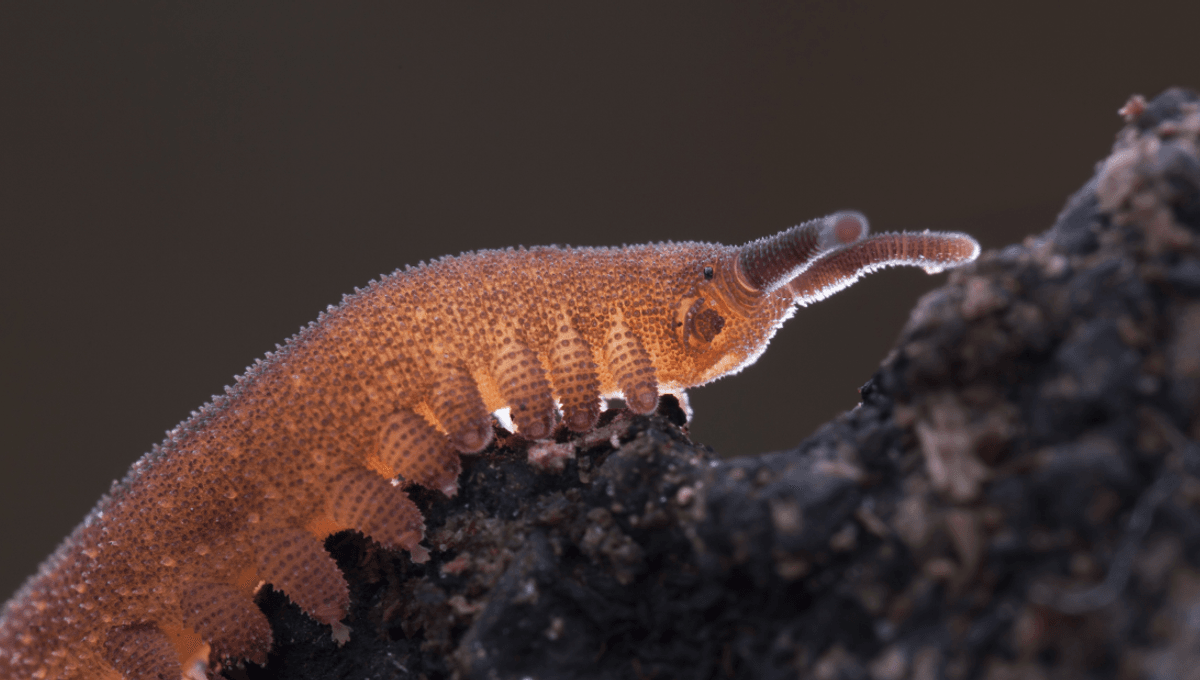
The velvet worm is pretty cute as invertebrate predators go. A leathery rope of an animal with a fuzzy, velvet-like texture. It has two antennae making it look a bit like Zuul, but when it’s time to fight, it takes inspiration from Spiderman.
ADVERTISEMENT
Velvet worms are sensitive to air currents, so despite being almost blind they know when a good meal is within reach. To catch it, they rear up and brandish two appendages like a cowboy in a Western, firing reels of deadly silly string – a kind of slime that has fascinated scientists for years. Why? Because it behaves unlike any other goo we see in nature.
This liquid-to-solid transformation is very unusual and faster than the better-known silk spinning by spiders.
Prof. Ali Miserez
“It is stored as a viscous liquid in a specialized gland, from which it is rapidly ejected outside the body from their specialized ‘oral papillae’,” said Professor Ali Miserez, Nanyang Technological University, Singapore, to IFLScience. “Within a few seconds, this viscous liquid (the slime) transforms into a stiff and glassy fiber. This liquid-to-solid transformation is very unusual and faster than the better-known silk spinning by spiders for example.”
“Once the slime has fully solidified into an entrapping mesh (to capture prey), it is as stiff as synthetic nylon, but what is really remarkable is that if one soaks the solidified slime in water, over a few hours it will re-dissolve into a viscous solution. From this solution, fibers can be re-drawn. So, the entire process is repeatable, and the fibers are fully recyclable. This provides a great biomimicry example to produce the next generation of non-toxic, fully biodegradable bioplastics.”
We’ve known about these unique characteristics of velvet worm slime for a while, but in recent years, teams have been trying to get to the bottom of what it is about this slime that makes it behave in such an unusual way. A few years back, we made it as far as working out that proteins make up most of the slime, but they hadn’t yet been identified or sequenced.
Since we have found this protein in separate velvet worm species that diverged nearly 400 million years ago, this means that this different biological function is very ancient from an evolutionary perspective.
Prof. Ali Miserez
Now, a team including Miserez has discovered that the main component of velvet worm slime is a group of leucine-rich repeat (LRR) proteins, which resemble a family of proteins called toll-like receptors (TLRs). The study identified how specific LRR proteins interact to create the fiber network that gives velvet worm slime its unique properties, but it also turned up unexpected insights into the biological functions of these protein groups.
In biology, TLRs play key roles in the immune system, embryonic development, and neural function. Now, the researchers have uncovered a surprising twist in finding that these TLR-like LRR proteins serve a structural role, acting as molecular glue that binds other slime proteins together. This challenges previous assumptions about their biological function and expands our understanding of how these proteins can operate in nature.
“In this new research, we have unveiled a very different role of TLR proteins: they play a structural, mechanical role: essentially, they can be seen as a kind of ‘glue protein’ at the molecular level that brings together many other slime proteins to form the macroscopic fibers,” explained Miserez. “Since we have found this protein in separate velvet worm species that diverged nearly 400 million years ago, this means that this different biological function is very ancient from an evolutionary perspective.”
ADVERTISEMENT
Now that we’ve uncovered this ancient conserved molecular mechanism for fiber formation, the researchers hope it could pave the way for new and sustainable materials inspired by nature. Not bad for a wee velvet worm.
The study is published in the journal PNAS.
Source Link: Velvet Worms' Deadly Projectile Slime Unleashes Surprising Protein Discovery